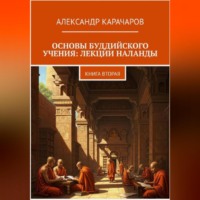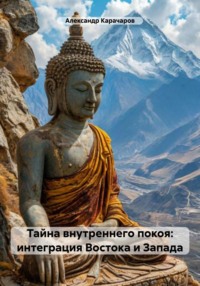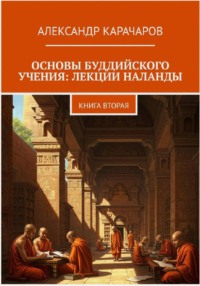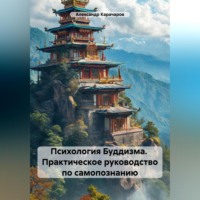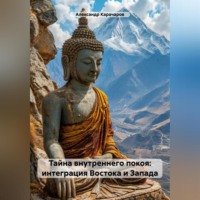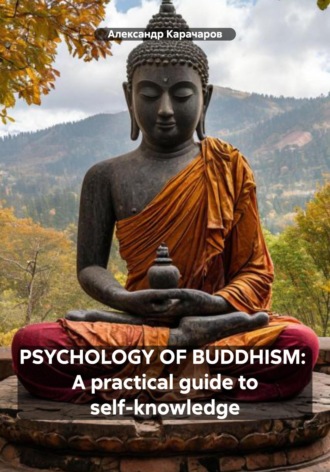
Полная версия
PSYCHOLOGY OF BUDDHISM: A practical guide to self-knowledge
This parable, like a mirror, reflects how our minds can cling to impressions and thoughts, even when events have long passed. And it is this clinging that often becomes the source of our suffering.
Therefore, the study of the mind is not just an academic exercise, but an urgent necessity in order to learn how to manage our lives, to free ourselves from the shackles of suffering and to find true happiness. Just as a gardener tends his garden by pulling weeds and watering flowers, we can learn to purify and transform our minds in order to cultivate virtues and wisdom that lead to awakening. But every step of the way brings us closer to understanding ourselves and to living a more harmonious and happy life.
Definition and Nature of Mind
So, we have found out that the study of the mind is like a key that opens the door to understanding ourselves and the world around us. But what is the mind? How to identify this elusive entity? In Buddhist psychology, the mind, or consciousness, is described as having two key characteristics, like the two wings of a bird: clarity and the ability to know.
His Holiness the Dalai Lama, like a wise teacher, explains this inner connection very figuratively:
"Knowing nature, or knowing agent… is called the mind, and it is immaterial… Cognitive acts have the nature of knowledge because of the basic nature of clarity, which underlies all cognitive acts. This is… the basic nature of the mind, clear light."
Imagine a pure, transparent crystal. It has clarity – you can see through it, as if through an unclouded spring. And at the same time, he is able to reflect light and images like a mirror – he has the ability to know. Our mind is like this crystal. It is clear in nature, which allows us to be aware of and perceive the world around us, like a window open to reality. And he has the ability to know – to see, to hear, to feel, to think, like a sensitive instrument that registers all impressions.
The Dalai Lama, like a poet, calls this basic nature of the mind "clear light." This is a very beautiful metaphor. Imagine a cloudless night sky strewn with stars. The sky itself is clear, and the stars are the objects of our cognition. The light emanating from the stars becomes visible through this clarity.
In the Buddhist tradition, different terms are used to refer to the mind, like different facets of the same gem. In Sanskrit, the word is citta, and in Tibetan, it is sems. These words encompass a wide range of mental activities, from the simplest sensations to the most complex intellectual processes.
In order to better understand how our minds work, Buddhist psychology, like a skilled cartographer, offers different classifications of mental activities. One of the main ones is the sevenfold division of types of perception, which is as if we divide all the ways in which our minds interact with the world into seven main categories.
Imagine how we perceive the world through our five senses: sight, like a window through which we see the colors of the world; hearing is like an instrument that catches the sounds of life; the sense of smell, like an invisible thread that connects us with aromas; Taste, like the palette of sensations on the tongue; and touch, like touching reality. These are five of the seven parts. The sixth part is our mental perception, like the inner voice that generates thoughts and ideas. The seventh part is our consciousness, like the conductor of an orchestra, combining all these types of perceptions into a single stream of experience.
This division, like the anatomy of the mind, helps us understand that our mind is not just a homogeneous mass, but a complex system consisting of various aspects, each of which plays a different role in our perception of reality.
Remember how you look at the picture. Your eyes (vision) perceive colors and shapes like a painter capturing details. At the same time, you can hear sounds around you (hearing), like a melody accompanying a visual image. Thoughts and associations associated with this picture (mental perception) arise in your mind, like an internal dialogue interpreting what you see. And all these sensations and thoughts come together in your mind, like threads weaving into a tapestry, creating your holistic experience of this moment.
Exploring these different aspects of the mind, like diving into the depths of the ocean, allows us to better understand how our thoughts and emotions arise, how we form our view of the world, and how we react to different situations. This is the first step on the way to learning to control your mind like a rider bridling a wild steed, and to live more consciously and happily.
The Sevenfold Division of Types of Perception (Tib. blo rigs bdun)
Now let's dive deeper into these seven facets of our perception, as if in the seven rooms of our minds, each of which reveals its own way of knowing the world.
Direct perception (Skt. pratyakṣa; Tib. mngon sum):
It's like a first look at the world, pure and unclouded by thoughts. Imagine looking at a bright red flower. At that moment, there are no judgments, no comparisons, just a pure visual sensation of the red color and shape of the flower. This is direct perception – pure sensory experience, free from conceptual layers.
Example: Imagine that you are drinking hot tea. The moment the liquid touches your tongue, you feel warmth and taste. This is pure, immediate perception – a feeling of warmth and sweetness without the admixture of thoughts about whether this tea is good, how much it costs or who made it.
Parable: Once a man who was blind from birth asked a sighted man: "What is white?" The sighted man tried to explain, comparing white with snow, with clouds, with swan down. But the blind man did not understand. Then the sighted man took a shell in his hands and gave it to the blind man to touch, saying: "White is like this smooth, hard surface." What is the color white. But he knew only the sensation of touch, and not the visual experience of whiteness itself. This parable, like a mirror, reflects how difficult it is to convey direct sensory experience through concepts.
Inference (Skt. anumāna; Tib. rjes dpag):
This kind of cognition, like a wise detective, is based on logic and reasoning. Imagine that you see smoke rising from behind a hill. You do not see the fire itself, but from your experience and knowledge that smoke usually accompanies a fire, you conclude that there is a fire burning behind the hill. Inference is the ability of our mind to draw conclusions based on available facts and logical connections.
Example: You wake up in the morning and see that the asphalt in the yard is wet, and there are drops of water hanging on the trees. You did not see how it rained, but based on these signs, you conclude that it rained at night.
Parable: Once the sage saw the tracks of large hooves on the bank of the river. He carefully examined them and said to his disciples: "These tracks belong to a huge elephant, which is lame on one leg, hungry and carries a lot of luggage." The disciples were surprised: "How can you know this without seeing the elephant?" The sage explained: "The footprints are deep, which means that the elephant is very heavy. One leg leaves a less deep mark, which means it is lame. There is no grass around the tracks, which means that he is hungry. And the uneven depth of the tracks indicates that he is carrying a heavy load." This parable, like a magnifying glass, shows the power of inference based on careful observation and logical thinking.
Subsequent knowledge (Skt. paricchinna-jñāna; Tib. bcad shoes):
It's like meeting an old friend – recognizing something that we've already perceived. When you meet someone you know on the street, you immediately recognize their face, voice, or behavior. This is subsequent cognition – our mind compares the current perception with the information stored in the memory and identifies the object.
Example: You hear a familiar tune on the radio. After a few seconds, you recognize the song and remember its name and artist. This is the subsequent cognition – your mind compares what you heard with the information stored in your memory.
Parable: A monk who had spent many years in seclusion in the mountains came down to the city. He saw many unfamiliar things and people. But when he heard the sound of a bell coming from the temple, he immediately recognized it.
Correct assumption (Skt. manaḥ-parīkṣā; Tib. yid dpyod):
It's like an intuitive insight, a correct guess based on limited information. Imagine that you hear a meow outside the door. If you don't see a cat, you're still very likely to assume that there's a cat there.
Example: Your friend is usually late for meetings. You agreed to meet at a café at 7 p.m. At 7:15 a.m. he's still gone. You assume that he's likely to stay another 10-15 minutes, and this assumption turns out to be correct.
Parable: Once a traveler got lost in the forest. He saw two roads diverging in different directions. On one road there were fresh tracks leading deep into the forest, and the other was overgrown with grass. The traveler assumed that no one had walked along the overgrown road for a long time, and decided to follow the road with footprints. This parable shows how, even with a lack of information, we can make the right assumption based on common sense and intuition.
Direct perception without definition (Skt. aniyata-pratibhāsa; Tib. snang la ma nges pa):
It's like a fleeting vision, a first impression, but it's even more fleeting and indefinite. Imagine that you catch a glimpse of something out of the corner of your eye. You are aware that something has happened, but you don't have time to determine what it is. This direct perception without definition is a primordial sensory impression that has not yet been clearly formed and named in our minds. It's like a shadow flashing on a wall – we see movement, But we don't know what caused it.
Example: You are sitting in a quiet room and suddenly you hear a rustle in the next room. You are aware that there was a sound, but you cannot immediately determine what it was – whether a book fell, a mouse ran by, or something else.
Parable: A disciple asked his Zen teacher, "What is mind?" The teacher suddenly shouted and clapped his hands. The disciple shuddered at the surprise. The teacher said, "This is mind—pure awareness of the moment without any thoughts or definitions." This parable, like a flash of lightning, illustrates the fleeting nature of pure perception that precedes conceptualization.
Doubt (Skt. saṃśaya; тиб. Di Tashome):
It's like a swing, oscillating between two or more possibilities. Imagine not being able to remember if you turned off the iron when you left the house. Your mind is torn between two options: "turned off" and "didn't turn off", causing a feeling of anxiety. Doubt is a natural part of our cognitive process when we are faced with a lack of information or conflicting data.
Example: You are offered to invest money in a new project that sounds very tempting. On the one hand, you see the potential benefit, on the other hand, you feel apprehension and uncertainty.
Parable: One day a man was standing on the bank of a river and could not decide whether to ford it or to take a boat. He doubted whether it was shallow enough to make the boat capsize. His doubts paralyzed him like fetters, and he was never able to get to the other side. interfering with decision-making and action.
False cognition (Skt. Viparaya-jñāna; тиб. People She):
It's like a mirage in the desert, a misperception or a misunderstanding of reality. Imagine that in the desert you see a mirage, a shiny surface that looks like water. Your mind mistakenly interprets the visual sensations as water, when in fact it's just hot sand. False cognition is a distortion of reality where our mind mistakes an illusion for reality. This can be due to a lack of information, bias, or simply a perceptual error.
Example: You look at a straight stick that is half submerged in water, and it appears to be broken at the water-air interface. This is an optical illusion – a false perception caused by the refraction of light.
Parable: One night, a man was walking along the road and saw a rope coiled up in the dark. He was frightened, thinking it was a snake, and he ran away. Only in the morning, in the light of the sun, did he see that it was just a rope. This classic Buddhist parable, like a lantern in the night, illustrates how our minds can misinterpret reality, creating fears and illusions there, where there are none.
Understanding these seven types of perception is like a clue to the mystery, helping us to become more aware of how our minds interact with the world and how errors in our cognition can arise. This is the first step to developing wisdom and the ability to see things as they really are. As one wise Buddhist monk said, "To get rid of illusions, we must first understand how they arise." Exploring these seven aspects of our perception is an important step on this path that leads to a clearer and more conscious understanding of ourselves and the world.
Now let us deepen our understanding of these seven facets of our perception, as if peering into the ancient wisdom scrolls of the Buddhist teachings, which, like light, shed truth on the nature of our mind.
Direct Perception: Buddhist texts, like echoes of centuries, emphasize the paramount importance of direct experience as the foundation of true knowledge. In the Majhima Nikaya, the Buddha, like a wise teacher, exhorts us to see things as they are, without the mediation of concepts or interpretations.
"Oh bhikkhus, when you see the form with the eye, you simply see the form. When you hear a sound with your ear, you just hear the sound. When you smell a smell through your nose, you just smell the smell. When you taste with your tongue, you just taste it. When you touch your body, you just feel the touch. When you know a thought with your mind, you simply know a thought."
This passage emphasizes the need for awareness and being in the present moment, without immediately labeling and judging our sensory experiences.
Inference: Buddhist logic (pramana), like a sharp sword, attaches great importance to inference as a valid source of knowledge. However, the Buddhist texts, likewise warnings, remind us of the need to distinguish between superficial understanding based on reasoning and deep understanding that arises from meditation and contemplation. The Golden Light Sutra speaks of the importance of distinguishing between these two types of understanding.
"Rely on your own experience, not the words of others. Rely on your own reason, not on other people's opinions. Rely on your own wisdom, not blind faith."
While inference is valuable as a tool, it must be supplemented by personal experience and intuitive understanding.
Subsequent Cognition: The Buddhist teachings, like a river of time, speak of the impermanence of all things. Our memories and recognition of objects are based on past impressions, which are themselves changeable. The Visuddhimagga (Path of Purification) describes the process of the arising and disappearance of mental images, emphasizing the transience of our experience and therefore of our subsequent cognition.
"Everything composite is impermanent, everything composite suffers, all dharmas are devoid of self."
Our recognition, like a shadow, is based on memory, which can be imperfect and subject to change.
Correct Assumption: Although there is no explicit mention of "correct guessing" as a separate category in Buddhist texts, the principle of right thinking (samma sankappa) in the Noble Eightfold Path implies the ability to make wise and well-founded assumptions based on compassion and wisdom.
"Right thinking is aimed at renunciation, the absence of ill will and the absence of cruelty."
A correct assumption, like a compass, in a Buddhist context, would be based on ethical principles and the desire for the welfare of all beings.
Direct Perception Without Definition: This state is often described in the context of vipassana meditation (insight meditation), like a safe haven. In the initial stages of practice, we learn to observe our sensations and thoughts without evaluating or categorizing them.
"Just observe, just notice, just be here."
Many Buddhist teachers, like guides, emphasize the importance of this non-conceptual perception in developing a deep understanding of reality.
Doubt: In Buddhism, doubt, like a thorny bush, is seen as one of the five obstacles to enlightenment. However, this does not mean that doubt is always harmful. Healthy doubt, like the wind, can motivate us to investigate and seek the truth. In the Kalama Sutta , the Buddha, like a wise counselor, admonishes us not to blindly believe in authorities, traditions, or rumors, but to test everything by experience.
"Do not believe the reports, do not believe the traditions, do not believe the rumors, do not believe the scriptures, do not believe the assumptions, do not believe the probabilities, do not believe the thought that 'this is our opinion,' do not believe the authority of teachers or elders. But when you yourself know that these things are not good, these things are evil, these things are condemned by the wise, these things, if practiced and observed, lead to harm and suffering, then give them up."
Doubt, like a tool, should be used for research, not as a cause for stagnation.
False cognition: The doctrine of emptiness (sunyata), like the sun, is central to Mahayana Buddhist philosophy. It says that all phenomena are devoid of their own, independent essence. Our ordinary perception of the world as consisting of solid, self-existent objects is a form of false cognition based on illusion. The Heart Sutra states:
"Form is emptiness, emptiness is form; Emptiness is not different from form, form is not different from emptiness. The same applies to sensation, perception, mental formations, and consciousness."
"Understanding emptiness is like a key that helps us free ourselves from false beliefs about reality and see the world as it really is, interconnected and constantly changing."
These passages from the Buddhist teachings deepen our understanding of the seven types of perception like precious threads and show how these categories relate to key Buddhist principles such as mindfulness, wisdom, impermanence, right thinking, and emptiness. Exploring these aspects of our mind, like diving into a deep well, is an important step on the path to self-knowledge and liberation from suffering.
Chapter 2. Beyond Illusions: Meeting the Immediate
Immediate Knowledge – Looking Beyond the Veil of the Mind
"The mind is like a wild elephant. If left unchecked, it will only bring destruction. But if he is tamed, he will become the greatest helper." – Tibetan proverb
Imagine a moment of absolute silence when all external noises cease and all that remains is pure, unclouded awareness. This is not a dream, not a fantasy, but a moment of genuine clarity, when the mind, like the calm surface of a lake, reflects reality without distortion. It is in this ability of our consciousness that lies the key to the deepest understanding of ourselves and the world – something that in Buddhist psychology, especially in the tradition of the great Nalanda Monastery, is called direct perception (Skt. pratyakṣa; Tib. mngon sum).
Think for a moment: How many times a day do we actually see, hear, and feel the world as it is, without the admixture of our biases, expectations, and interpretations? More often than not, our minds are like a stirred sea, where waves of thought and emotion distort the reflection of the truth. But imagine that there is a way to calm these waves and see reality in all its pristine purity.
"Knowing nature, or knowing agent… is called the mind, and it is immaterial… Cognitive acts have the nature of knowledge because of the basic nature of clarity, which underlies all cognitive acts. This is… the basic nature of the mind, clear light," says His Holiness the Dalai Lama. These words penetrate like a ray of light to the very heart of our minds, pointing to our innate capacity for clear and immediate knowledge.
But why should we, modern people living in a world of information noise and constant haste, immerse ourselves in the study of such subtle aspects of Buddhist psychology? The answer is simple and deeply personal: to gain mental health, peace of mind, and genuine understanding. After all, many of our sufferings, anxieties, and disappointments stem from misinterpretations of reality, from misconceptions that we accept as truth.
Remember how often we react not to the fact itself, but to our interpretation of this fact. The boss frowns – and now a whole scenario about our incompetence and impending dismissal is born in our minds. A friend doesn't respond to the message right away – and we already feel rejected. These mental constructs, often having nothing to do with reality, poison our lives and undermine our mental health.
"The mind is like a monkey jumping from branch to branch, constantly distracted and grasping at anything," say Tibetan monks, drawing an analogy with the restless nature of our everyday consciousness. But in the Nalanda Tradition we are taught that behind this hustle and bustle lies the potential for infallible cognition, free from conceptuality. This is the essence of direct perception, which, according to this ancient wisdom, is of four kinds:
Конец ознакомительного фрагмента.
Текст предоставлен ООО «Литрес».
Прочитайте эту книгу целиком, купив полную легальную версию на Литрес.
Безопасно оплатить книгу можно банковской картой Visa, MasterCard, Maestro, со счета мобильного телефона, с платежного терминала, в салоне МТС или Связной, через PayPal, WebMoney, Яндекс.Деньги, QIWI Кошелек, бонусными картами или другим удобным Вам способом.




